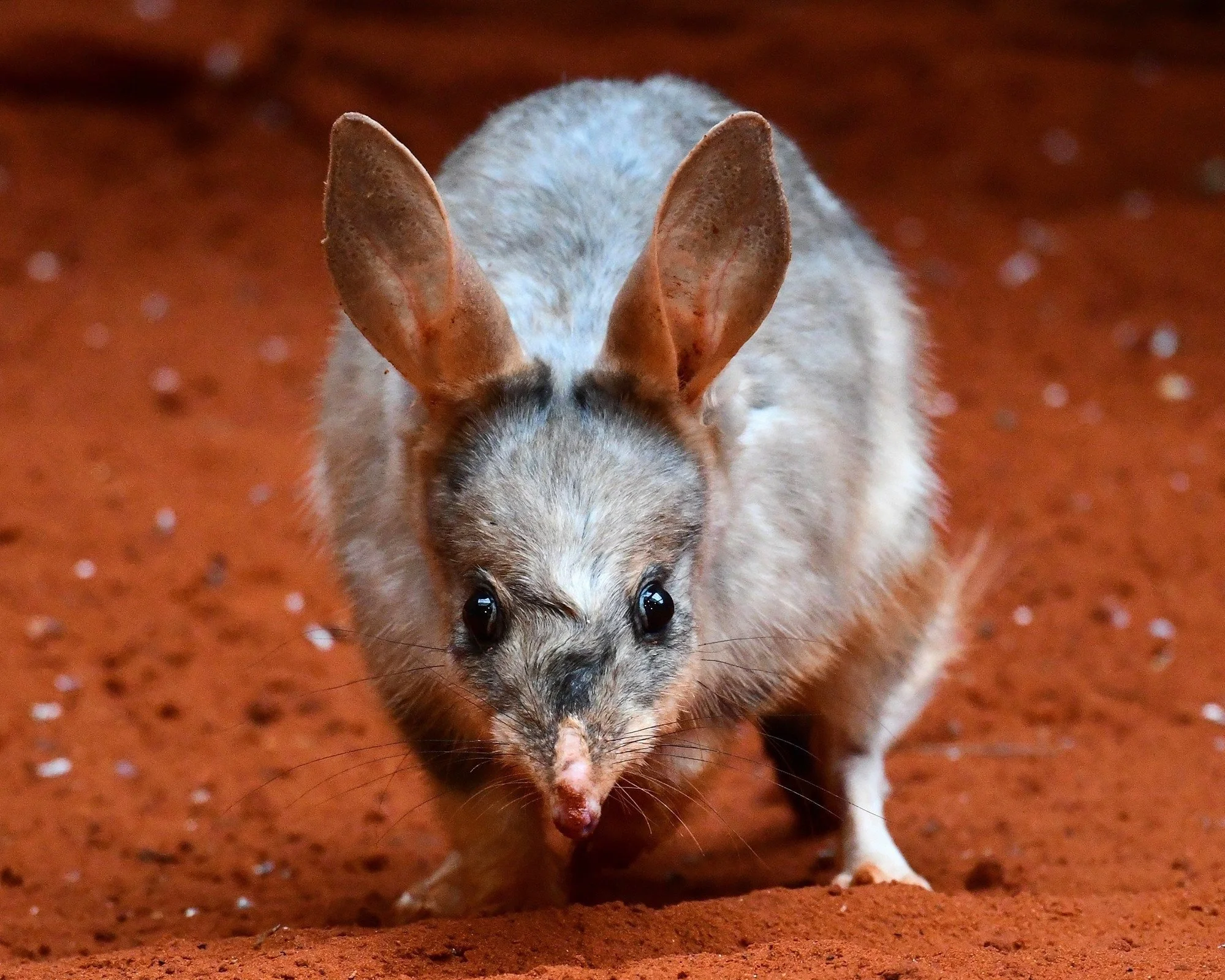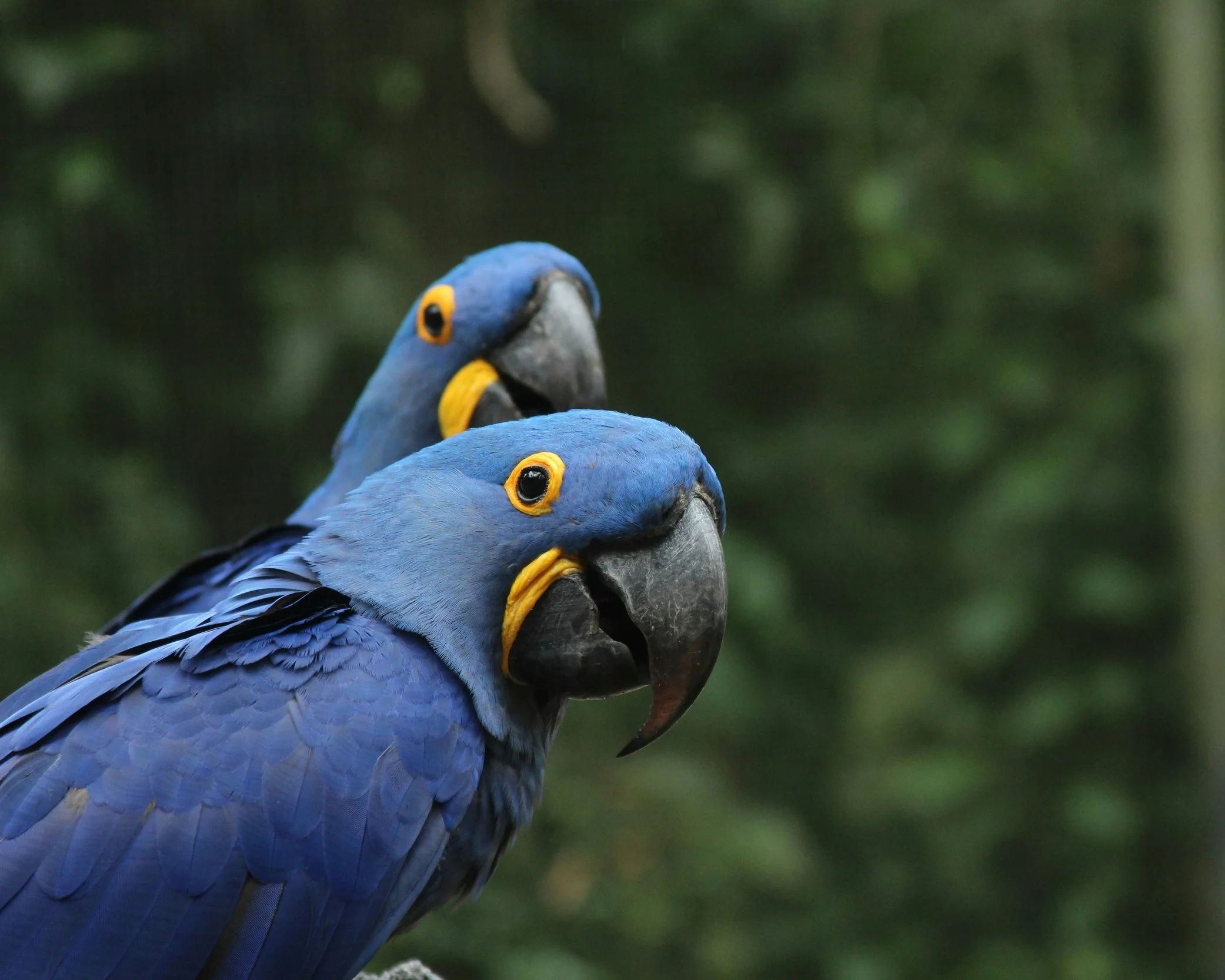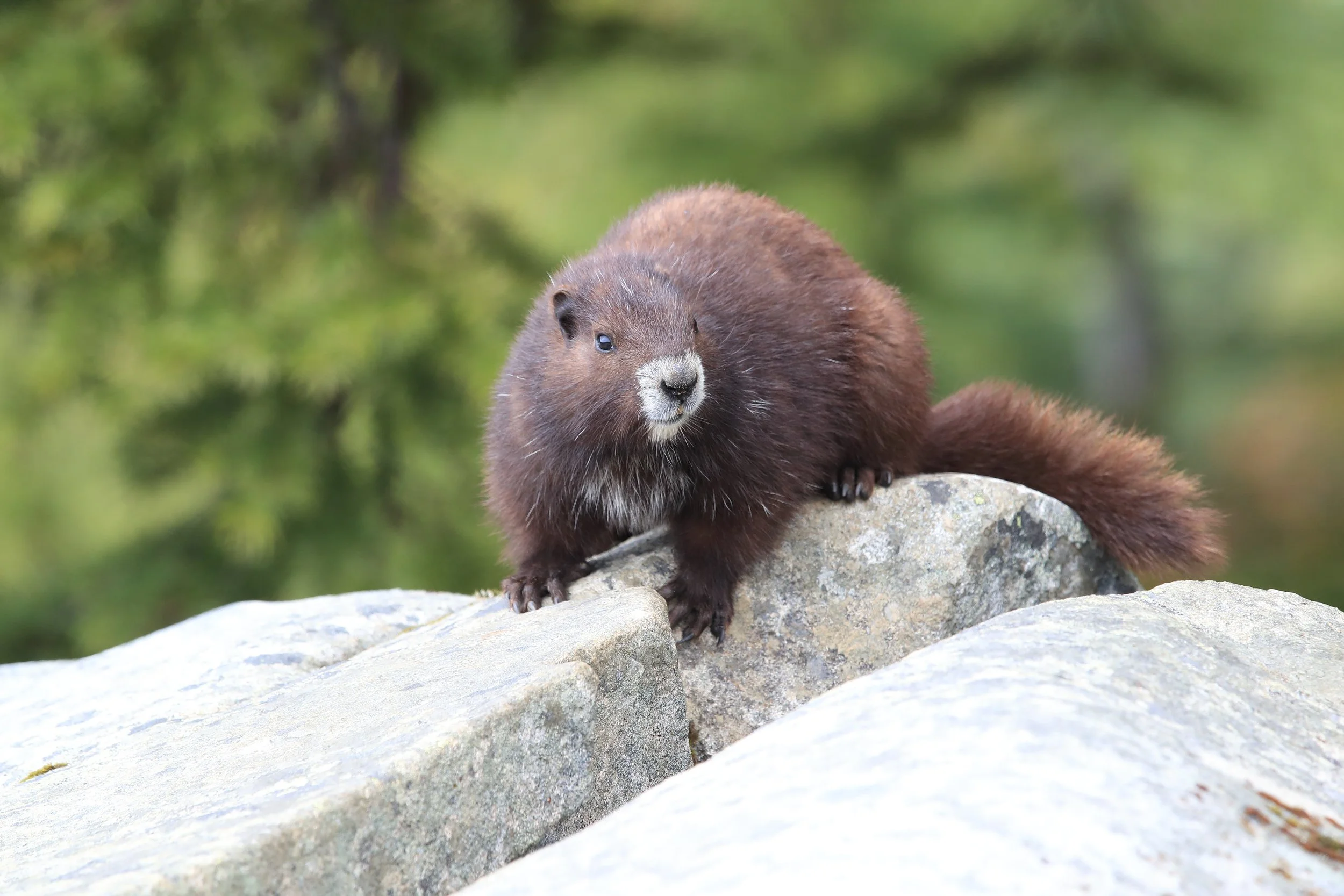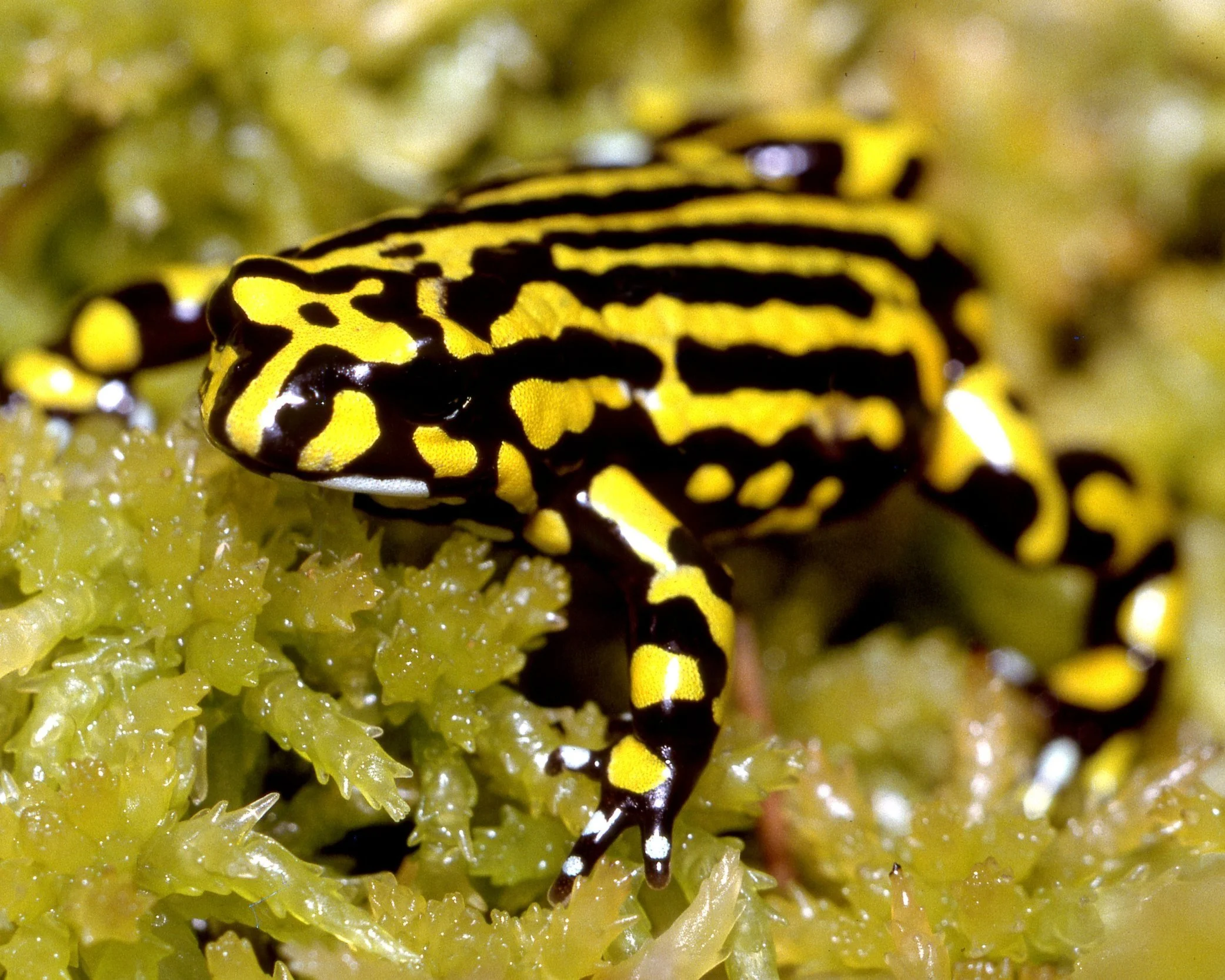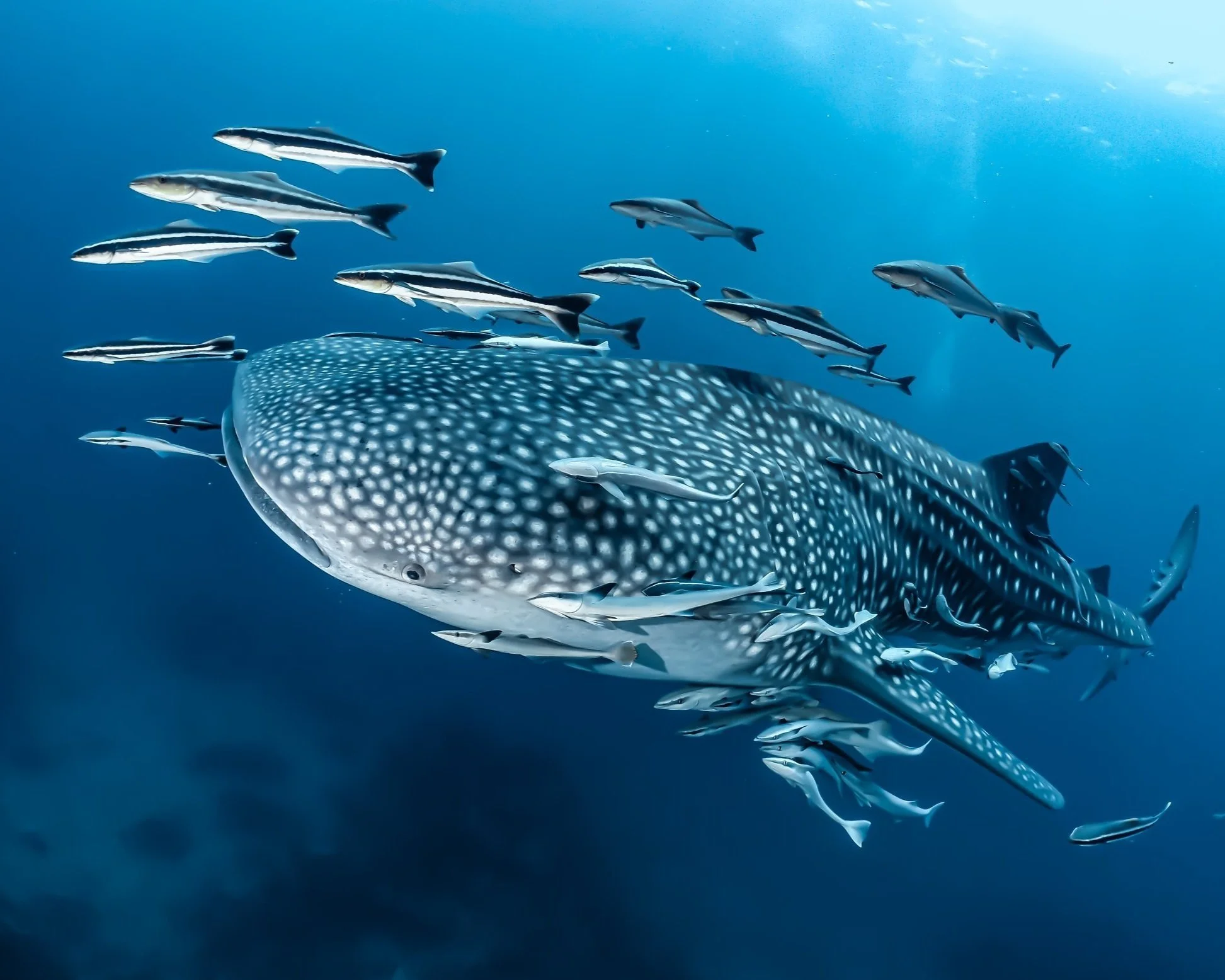Reference Genomes Underpinning Species Conservation:
Case studies and examples from the Earth BioGenome Project (EBP)
Conservation genomics is a powerful tool harnessing the complete genetic blueprint of endangered and critically endangered species in order to more accurately examine how to best protect the species or even bring a highly threatened population back from the brink of extinction. Species conservation relies heavily on accurately identifying, differentiating, tracking, and counting species, which is of particular importance since the laws protecting biodiversity are typically established on a case-by-case basis at the species or subspecies level. This can pose significant hurdles to overcome for successful conservation management because the accurate delineation of species can be instrumental in determining the degree of protection a given species is awarded.
Ninu (Macrotis lagotis) is currently found in the greater sandy desert region of Australia, is listed as a vulnerable species, and its population size is decreasing according to the IUCN Red List (Burbidge and Woinarski, 2016). This reference genome was sequenced by the Threatened Species Initiative and BioPlatforms Australia. Photo taken by Yuanyuan Cheng.
Increased accessibility to high-quality reference genomes across the Tree of Life has revolutionized the conservation of endangered and critically endangered species and generated new ways of attempting species conservation. As the EBP efforts continue to gain speed, today reaching 3,319 genomes released (GoaT, Feb 2025, EBP status live), we wanted to look back through several EBP-affiliated projects and highlight a few of the conservation genomics applications that have been established, some that are in progress, and others that are currently laying the genomic groundwork for potential conservation applications to follow.
Reference Genomes to Enhance Conservation
Setting up the strong genomic framework of reference genomes, to enhance conservation genomics projects, has been one of the aims of EBP-affiliated projects since its inception (Lewin et al., 2018). In fact, several groups have explicitly targeted endangered and critically endangered species with the hope that a detailed high-quality reference genome might inform conservation and allow for novel conservation approaches. For example, the leaders of the Threatened Species Initiative in Australia have worked to harness both Indigenous knowledge and genomics to assess the vulnerable marsupial known as the Greater bilby or Ninu (Macrotis lagotis) (pictured). The Ninu is the only remaining member of its family Thylacomyidae and the only other bilby species, the Lesser bilby, is now extinct. The Ninu reference genome is one of the highest-quality reference genomes for any marsupial and it is enabling breakthroughs in conservation genomics and population studies to assess the genetic diversity of the remaining individuals (Hogg et al., 2024). Such studies can directly inform conservation by identifying desired individuals to translocate in an effort to enhance genetic diversity throughout the target population (Hogg et al., 2024). In fact, efforts to improve Ninu genetic diversity using genetically driven population management have already been successful within this vulnerable population (Hogg et al., 2024).
Hyacinth Macaw (Anodorhynchus hyacinthinus) is currently found in three main regions of Brazil, is listed as a vulnerable species, and its population size is decreasing according to the IUCN Red List (BirdLife International, 2016). This reference genome was sequenced by the Vertebrate Genomes Project.
Reference Genomes to inform breeding programs
Other EBP-affiliated projects have had similar success at coupling conservation genomics with population management in order to identify individuals most likely to enhance the gene pool of threatened populations. Habitat fragmentation, primarily due to the bisecting of habitats with cities or freeways, can be one major hurdle that wild populations need to overcome in order to maintain sufficient genetic diversity throughout the population. The Vertebrate Genomes Project is an EBP-affiliated project that has been working tirelessly to generate high-quality reference genomes for hundreds of vertebrate species (Rhie et al., 2021), including the Hyacinth Macaw (Anodorhynchus hyacinthinus) (pictured). The macaw reference genome was then used by another EBP-affiliated project–the Genomics of the Brazilian Biodiversity–for a population study, where researchers provided a first characterization of population structure, diversity, inbreeding, and gene flow of the remaining macaw population (Vilaça, et al., 2024). The project leaders hope that population studies like this one will inform ex-situ breeding programs to benefit the long-term survival of the species (personal communication, Alexandre Aleixo). A similar effort is also underway for the neotropic Harpy Eagle (Harpia harpyja), which is listed as a vulnerable population with notedly low genetic diversity (Banhos et al., 2016). The Genomics of Brazilian Biodiversity is currently working on a large-scale population genomics study, leveraging another high-quality reference genome–sequenced by the Vertebrate Genomes Project–into an invaluable resource informing captive breeding programs that are focused on increasing the genetic diversity of the remaining Harpy Eagle population (Canesin et al., 2024).
Vancouver Island marmot (Marmota vancouverensis) is a critically endangered species (Roach, 2017) and the only known wild populations are found on Vancouver Island British Columbia, Canada. This reference genome was sequenced by the Canadian BioGenome Project in collaboration with CanSeq150.
Reference Genomes to delay the Threat of Extinction
Around the globe, the human decimation of populations of plants and animals, to the point of near extinction, is a recurring theme. Today, conservation genomics groups are targeting some of these species for human intervention. The critically endangered Black Abalone (Haliotis cracherodii) was threatened by a combination of overhunting, pollution in the intertidal zones, and the onset of a highly virulent bacterial disease (Wooldridge et al., 2024). Now, groups such as the California Conservation Genomics Project are utilizing genomic insights to assess the genetic diversity of the remaining population and investigate the connectivity between these Abalone populations to propose a comprehensive management plan for the Black Abalone (Fiedler et al., 2022; Wooldridge et al., 2024).
Detailed genomes can provide valuable insights into the stability of very small populations; and they can identify signs of poor genetic health in species that might more accurately predict species extinction (Paez et al., 2024). For example, in 2003 fewer than 30 wild Vancouver Island marmots (Marmota vancouverensis) were found (pictured) and the species was then classified as critically endangered by IUCN, first in 2008, then subsequently in 2013, and again in 2017 (Nagorsen et al., 2008 and 2013; Roach, 2017). Today, after extensive initial conservation efforts, the Vancouver Island marmot population has started to demonstrate significant recovery with the wild population reaching a record of 381 marmots in 2024 (MRFAR, 2024; Brougham, 2025). However ongoing genomics research has indicated that the marmot population has very low genetic diversity (Barrett et al. 2022), which can make it challenging to identify unique genetic fingerprints among individuals. The future goal of this research is to use the newly assembled (soon to be released)—chromosome level reference genome—produced by Canadian BioGenome Project, in collaboration with CanSeq150, to compare DNA from marmots and select mating pairs based on genetic dissimilarity to protect the remaining genetic diversity of the Vancouver Island marmot population. Without such efforts, the population risks being unable to cope with future threats such as emerging diseases and climate change.
Southern Corroboree Frog (Pseudophryne corroboree) has wild populations currently found only in Kosciuszko National Park in New South Wales, Australia. It is listed as a critically endangered species and its population size is decreasing according to the IUCN Red List (IUCN SSC Amphibian Specialist Group, 2022). This reference genome was sequenced by the Vertebrate Genomes Project.
Reference Genomes to Assess Susceptibility and Resistance to Diseases
Another aspect of conservation genomics is focused on identifying the genetic factors controlling the degree of susceptibility or resistance to diseases of members of a given population. For example, Chytridiomycosis is an infectious disease that poses a significant extinction threat to many amphibians, including the critically endangered Southern Corroboree Frog (Pseudophryne corroboree) (pictured). The Corroboree Frog reference genome, generated by the Vertebrate Genomes Project, was later used by the Amphibian Genomics Consortium to advance downstream population genomics studies (Kosch et al., 2024). This study identified subsets of the Southern Corroboree Frog population with increased genetic resistance to the disease (Davidson et al., 2024). These findings can directly inform selective breeding to improve genetic resilience to disease in vulnerable populations (Davidson et al., 2024) and provide a framework for similar conservation attempts in other threatened amphibian groups. The continued efforts by the Amphibian Genomics Consortium will be instrumental in translating the Corroboree Frog genome into actionable conservation strategies, such as targeted genetic interventions, selective breeding, and genetic engineering for chytrid resistance (Kosch et al., 2022). Similarly, the Bat1K group has been working hard to sequence several threatened bat species, among them the Greater mouse-eared bat (Myotis myotis) (Jebb et al., 2020), which is a species threatened by a fungal infection called the white-nose syndrome (Twort et al., 2024). In this case, researchers have been able to utilize the Bat1K reference genome to embark on population studies to tease apart the factors contributing to susceptibility or resistance to this fungal infection at a genomic level (Twort et al., 2024). Moving forward, the Bat1K working groups are putting strong efforts into informing conservation strategies by prioritizing vulnerable or threatened species for full genome sequencing, laying down a strong genomic foundation for conservation work to come.
Whale Shark (Rhincodon typus) has a circumtropical distribution, is listed as an endangered species, and its population size is decreasing according to the IUCN Red List (Pierce and Norman, 2016). This reference genome was sequenced by Squalomix.
Conservation Genomics Framework–paving the way forward
As EBP-affiliated projects continue to generate new genomes the clear benefit to conservation genomics efforts will deepen. Groups such as EBP-Norway have released genomes from difficult-to-sample Arctic species like the Snowy Owl (Bubo scandiacus) and Atlantic Puffin (Fratercula arctica). Hopefully, conservation work around these vulnerable and decreasing bird populations will be strengthened in the future by the strong genomic foundation these reference genomes provide.
Squalomix and Darwin Tree of Life have sequenced the Whale Shark (pictured) and the Basking Shark, respectively, both of which are endangered and decreasing according to their IUCN Red List abundance and distributions (IUCN, 2024). In Brazil, the endangered Pink river dolphin or Boutu (Inia geoffrensis), was sequenced by the Cetaceans Genome Project and is currently in the process of informing better conservation efforts around this threatened dolphin species. In Europe, the White-Tailed Sea Eagle (Haliaeetus albicilla), the U.K.’s largest bird of prey, was recently sequenced during a collaboration between Darwin Tree of Life and European Reference Genome Atlas (Pálsson et al., 2024). This reference genome will enable scientists to monitor reintroductions of this iconic species and better track their migration range (Pálsson et al., 2024). Ongoing work throughout Africa by the African BioGenome Project and others, will continue to promote the conservation of at-risk African biodiversity, and we eagerly look forward to more conservation insights from the African BioGenome Project as the framework for genomics in Africa by African experts continues to gain traction (Sharaf et al., 2024).
Today, we are facing a global crisis in terms of biodiversity loss in what scientists agree is the 6th global extinction event. However, as EBP scientists around the globe continue to demonstrate, we can more rapidly bridge the gap between genomics and conservation actions when working together as a global community. Together we have the ability to advance technologies allowing for more affordable and widespread full genome sequencing advantages. And together the scientific community can inform and potentially direct conservation policies to better protect our global diversity. As EBP-affiliated projects continue genome sequencing species across the Tree of Life, we expect to see many more examples of how these high-quality reference genomes can directly benefit and inform conservation genomics.
Written by: Anna Bramucci (Earth BioGenome Project: Genomic Insights Coordinator)
References
Banhos, Aureo, Tomas Hrbek, Tania M. Sanaiotti, and Izeni Pires Farias. "Reduction of genetic diversity of the Harpy Eagle in Brazilian tropical forests." PloS one 11, no. 2 (2016): e0148902.
Barrett, Kimberley, G., Geneviève Amaral, Melanie. Elphinstone, Malcolm L. McAdie, Corey S. Davis, Jasmine K. Janes, John Carnio, Axel Moehrenschlager and Jamieson C. Gorrell. “Genetic management on the brink of extinction: sequencing microsatellites does not improve estimates of inbreeding in wild and captive Vancouver Island marmots (Marmota vancouverensis).” Conservation Genetics 23 (2022): 417-428.
BirdLife International. “Anodorhynchus hyacinthinus. The IUCN Red List of Threatened Species 2016: e.T22685516A93077457.” (2016) website: https://dx.doi.org/10.2305/IUCN.UK.2016-3.RLTS.T22685516A93077457.en. Accessed on 20 February 2025. Anodorhynchus hyacinthinus page on IUCN: here.
Burbidge, A.A. & Woinarski, J. “Macrotis lagotis. The IUCN Red List of Threatened Species 2016: e.T12650A21967189.”(2016) website: https://dx.doi.org/10.2305/IUCN.UK.2016-2.RLTS.T12650A21967189.en. Accessed on 20 February 2025. Macrotis lagotis page on IUCN: here.
Brougham, L. 2025. “Record number of endangered Vancouver Island marmots, Pups spotted in 2024.” date accessed: 2025, February 14. Check News. https://cheknews.ca/record-number-of-endangered-vancouver-island-marmots-pups-spotted-in-2024-1239118/
Canesin, Lucas Eduardo Costa, Sibelle T. Vilaça, Renato RM Oliveira, Farooq Al-Ajli, Alan Tracey, Ying Sims, Giulio Formenti et al. "A reference genome for the Harpy Eagle reveals steady demographic decline and chromosomal rearrangements in the origin of Accipitriformes." Scientific Reports 14, no. 1 (2024): 19925.
Davidson, Mikaeylah J., Lee Berger, Amy Aquilina, Melissa Hernandez Poveda, Daniel Guinto, Michael McFadden, Deon Gilbert et al. "Exposure to low doses of Batrachochytrium dendrobatidis reveals variation in resistance in the Critically Endangered southern corroboree frog." bioRxiv (2024): 2024-12.
Fiedler, Peggy L., Bjorn Erickson, Michael Esgro, Mark Gold, Joshua M. Hull, Jennifer M. Norris, Beth Shapiro, Michael Westphal, Erin Toffelmier, and H. Bradley Shaffer. "Seizing the moment: the opportunity and relevance of the California Conservation Genomics Project to state and federal conservation policy." Journal of Heredity 113, no. 6 (2022): 589-596.
Genomes on a Tree (GoaT). Website: https://goat.genomehubs.org/projects/EBP (Access date: February 20, 2025.)
Hogg, Carolyn J., Richard J. Edwards, Katherine A. Farquharson, Luke W. Silver, Parice Brandies, Emma Peel, Merly Escalona et al. "Extant and extinct bilby genomes combined with Indigenous knowledge improve conservation of a unique Australian marsupial." Nature ecology & evolution 8, no. 7 (2024): 1311-1326.
IUCN. “The IUCN Red List of Threatened Species. Version 2024-2.” website: https://www.iucnredlist.org. (2024): Accessed on (10 February 2025).
IUCN SSC Amphibian Specialist Group. “Pseudophryne corroboree. The IUCN Red List of Threatened Species 2022: e.T18582A78432063” (2022) website: https://dx.doi.org/10.2305/IUCN.UK.2022-2.RLTS.T18582A78432063.en. Accessed on 20 February 2025. Pseudophryne corroboree page on IUCN: here.
Jebb, David, Zixia Huang, Martin Pippel, Graham M. Hughes, Ksenia Lavrichenko, Paolo Devanna, Sylke Winkler et al. "Six reference-quality genomes reveal evolution of bat adaptations." Nature 583, no. 7817 (2020): 578-584.
Kosch, Tiffany A., Anthony W. Waddle, Caitlin A. Cooper, Kyall R. Zenger, Dorian J. Garrick, Lee Berger, and Lee F. Skerratt. "Genetic approaches for increasing fitness in endangered species." Trends in Ecology & Evolution 37, no. 4 (2022): 332-345.
Kosch, Tiffany A., María Torres-Sánchez, H. Christoph Liedtke, Kyle Summers, Maximina H. Yun, Andrew J. Crawford, Simon T. Maddock et al. "The Amphibian Genomics Consortium: advancing genomic and genetic resources for amphibian research and conservation." BMC genomics 25, no. 1 (2024): 1025.
Lewin, Harris A., Gene E. Robinson, W. John Kress, William J. Baker, Jonathan Coddington, Keith A. Crandall, Richard Durbin et al. "Earth BioGenome Project: Sequencing life for the future of life." Proceedings of the National Academy of Sciences 115, no. 17 (2018): 4325-4333.
MRFAR, 2024. “Marmot Recovery Foundation Annual Report” website: https://marmots.org/wp-content/uploads/2025/02/FINAL-web-2024-MRF-Annual-Report.pdf
Nagorsen, D.W. & NatureServe (Cannings, S. & Hammerson, G.). “Marmota vancouverensis. The IUCN Red List of Threatened Species 2008: e.T12828A3387226.” (2008) Accessed on 22 February 2025. Marmota vancouverensis page on IUCN: here.
Nagorsen, D.W. & NatureServe (Cannings, S. & Hammerson, G.). “Marmota vancouverensis. The IUCN Red List of Threatened Species 2013: e.T12828A43526735.” (2013)
website: https://dx.doi.org/10.2305/IUCN.UK.2013-1.RLTS.T12828A43526735.en. Accessed on 22 February 2025. Marmota vancouverensis page on IUCN: here.
Paez, Sadye, Robert HS Kraus, Beth Shapiro, M. Thomas P. Gilbert, Erich D. Jarvis, Vertebrate Genomes Project Conservation Group, Farooq Omar Al-Ajli et al. "Reference genomes for conservation." Science 377, no. 6604 (2022): 364-366.
Pálsson, Snæbjörn, Kristinn Haukur Skarphéðinsson, Julia Heintz, Pernilla Quarfordt, Ann-Sofi Strand, Ignas Bunikis, Olga Vinnere Pettersson, Wellcome Sanger Institute Tree of Life, and Darwin Tree of Life Consortium. "The genome sequence of the white-tailed eagle, Haliaeetus albicilla (Linnaeus, 1758)." Wellcome Open Research 9 (2024): 575.
Pierce, S.J. and Norman, B. (2016) “Rhincodon typus. The IUCN Red List of Threatened Species 2016: e.T19488A2365291.” website: https://dx.doi.org/10.2305/IUCN.UK.2016-1.RLTS.T19488A2365291.en. Accessed on 20 February 2025. Rhincodon typus page on IUCN: here.
Rhie, Arang, Shane A. McCarthy, Olivier Fedrigo, Joana Damas, Giulio Formenti, Sergey Koren, Marcela Uliano-Silva et al. "Towards complete and error-free genome assemblies of all vertebrate species." Nature 592, no. 7856 (2021): 737-746.
Roach, N. (2017) “Marmota vancouverensis. The IUCN Red List of Threatened Species 2017: e.T12828A22259184” website: https://dx.doi.org/10.2305/IUCN.UK.2017-2.RLTS.T12828A22259184.en. Accessed on 20 February 2025. Marmota vancouverensis page on IUCN: here.
Sharaf, Abdoallah, Lucky Tendani Nesengani, Ichrak Hayah, Josiah Ochieng Kuja, Sinebongo Mdyogolo, Taiwo Crossby Omotoriogun, Blessing Adanta Odogwu et al. "Establishing African genomics and bioinformatics programs through annual regional workshops." Nature Genetics 56, no. 8 (2024): 1556-1565.
Teeling, Emma C., Sonja C. Vernes, Liliana M. Dávalos, David A. Ray, M. Thomas P. Gilbert, Eugene Myers, and Bat1K Consortium. "Bat biology, genomes, and the Bat1K project: to generate chromosome-level genomes for all living bat species." Annual review of animal biosciences 6, no. 1 (2018): 23-46.
Twort, Victoria Gwendoline, V. N. Laine, Kenneth A. Field, Flora Whiting-Fawcett, F. Ito, M. Reiman, Tomas Bartonicka et al. "Signals of positive selection in genomes of palearctic Myotis-bats coexisting with a fungal pathogen." BMC genomics 25, no. 1 (2024): 828.
Vilaça, Sibelle Torres, Jeronymo Dalapicolla, Renata Soares, Neiva Maria Robaldo Guedes, Cristina Y. Miyaki, and Alexandre Aleixo. "Prioritizing Conservation Areas for the Hyacinth Macaw (Anodorhynchus hyacinthinus) in Brazil From Low‐Coverage Genomic Data." Evolutionary Applications 17, no. 11 (2024): e70039.
Wooldridge, Brock, Chloé Orland, Erik Enbody, Merly Escalona, Cade Mirchandani, Russell Corbett‐Detig, Joshua D. Kapp et al. "Limited genomic signatures of population collapse in the critically endangered black abalone (Haliotis cracherodii)." Molecular Ecology (2024): e17362.

